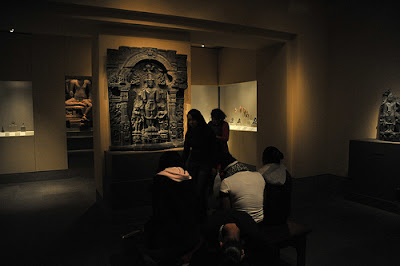The fifth and fourth centuries
B.C. were a time of worldwide intellectual ferment. It was an age of great thinkers, such as Socrates and Plato, Confucius and Laozi.
In
India, it was the
Age of the Buddha, after whose passing a religion developed that eventually spread far beyond its homeland.
 |
| Buddhism along the Silk Road at the Met, New York City, Jan. 9, 2013 (Asterix611/flickr) |
He then sat down in yogic meditation beneath a banyan tree [pipal or "sacred fig," the
Ficus religiosa, the forebear of world's oldest historically documented tree] until he achieved enlightenment. He was known henceforth as
the Buddha, or the "Enlightened One."
He found the Middle Path, rejecting both hedonism and asceticism. Buddhism proposes a life of good thoughts, good intentions, and straight living, all with the ultimate aim of achieving nirvana, release from [all conditioned] existence.
 |
| (Asterix611/flickr.com) |
For most beings, nirvana lies in the distant future, because Buddhism, like other
dharmas [doctrines] of India, believes in a cycle of rebirth.
Beings are reborn many times, each time with the opportunity to further perfect themselves or devolve. And it is their own karma -- the sum total of deeds, beneficial and harmful -- that determines the circumstances of future births.
The Buddha spent the remaining 45 years of his life teaching a doctrine and discipline and making vast numbers of converts. When he entered final nirvana, released from all rebirth, his body was cremated as was customary in India.
The cremated relics of the Buddha were divided into several portions and placed in relic caskets that were interred in large hemispherical mounds known as
stupas. Such monuments are centrally placed in Buddhist monastic complexes. They attract pilgrims from far and wide who come to experience the teaching, the monastic order, and even some small portion of the remains of the Buddha.
Stupas are enclosed by a railing that provides a path for respectful circumambulation. The sacred area is entered through gateways at the four cardinal points.
More 


































